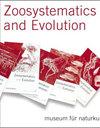Another微裂蛙属Cophixalus Boettger的巨型种,1892年产自巴布亚新几内亚山区,该属原冠类的首次记录
IF 0.9
2区 生物学
Q2 ZOOLOGY
引用次数: 0
摘要
新几内亚中部科迪勒拉山区热带雨林中描述了一新种。这一新种的雄性腰长超过44.0毫米,是该属中最大的成员之一;已知巴布亚其他唯一能达到这种大小的物种是1962年的C. riparius Zweifel。这个新物种与河滨瓢虫的不同之处在于其少量的测量特征,以及它独特的广告叫声,一种单一或快速连续发出的爆炸性“吠叫”。相比之下,在类型位置附近记录的河滨蝉的叫声是一系列拉长的,刺耳的呱呱声。对这两种鸟的叫声进行了分析和比较。这两个物种似乎也有不同的生态,新物种只在树上高处发现,而河滨瓢虫经常在森林地面或附近的植被中遇到。骨学特征的检查显示,在这两个物种中都存在软骨的前冠状体,代表了Cophixalus种属中前冠状体的第一次记录。传统上认为缺少前冠状体是定义Cophixalus的重要诊断特征,但这两个物种也缺少锁骨,锁骨被认为是Cophixalus的诊断特征,也是区分该属与近亲Oreophryne Boettger(1895)的关键特征。由于初步公布的遗传数据表明它们嵌套在Cophixalus中,我们将这两个物种保留在该属中,直到Cophixalus及其相关属,特别是Oreophryne的全面分子系统发育完成。本文章由计算机程序翻译,如有差异,请以英文原文为准。
Another giant species of the microhylid frog genus Cophixalus Boettger, 1892 from the mountains of Papua New Guinea and first records of procoracoids in the genus
A new arboreal species of the microhylid genus Cophixalus Boettger, 1892 is described from montane rainforest on Papua New Guinea’s central cordillera. With a male SUL exceeding 44.0 mm, the new species is among the largest members of the genus; the only other Papuan species known to reach this size is C. riparius Zweifel, 1962. The new species differs from C. riparius in a small number of mensural characters and by its distinct advertisement call, a single explosive ‘bark’ uttered singly or in rapid series. In contrast, calls of C. riparius recorded near the type locality are a series of drawn out, rasping croaks. Calls of the two species are analysed and compared. The two species also appear to have different ecologies, with the new species found only high in trees, while C. riparius is often encountered in vegetation on or near the forest floor. Examination of osteological features revealed the presence of cartilaginous procoracoids in both species, representing the first records of procoracoids in the speciose genus Cophixalus. Lack of procoracoids is traditionally considered an important diagnostic character for defining Cophixalus but both species also lack clavicles, a character considered diagnostic for Cophixalus and a key feature distinguishing the genus from the closely related Oreophryne Boettger, 1895. Because preliminary published genetic data indicate that they are nested within Cophixalus, we retain both species in that genus until a comprehensive molecular phylogeny of Cophixalus and related genera, particularly Oreophryne, is completed.
求助全文
通过发布文献求助,成功后即可免费获取论文全文。
去求助
来源期刊

Zoosystematics and Evolution
ZOOLOGY-
CiteScore
3.50
自引率
5.00%
发文量
34
审稿时长
16 weeks
期刊介绍:
Zoosystematics and Evolution, formerly Mitteilungen aus dem Museum für Naturkunde in Berlin, is an international, open access, peer-reviewed life science journal devoted to whole-organism biology. It publishes original research and review articles in the field of Metazoan taxonomy, biosystematics, evolution, morphology, development and biogeography at all taxonomic levels. The journal''s scope encompasses primary information from collection-related research, taxonomic descriptions and discoveries, revisions, annotated type catalogues, aspects of the history of science, and contributions on new methods and principles of systematics. Articles whose main topic is ecology, functional anatomy, physiology, or ethology are only acceptable when of systematic or evolutionary relevance and perspective.
 求助内容:
求助内容: 应助结果提醒方式:
应助结果提醒方式:


